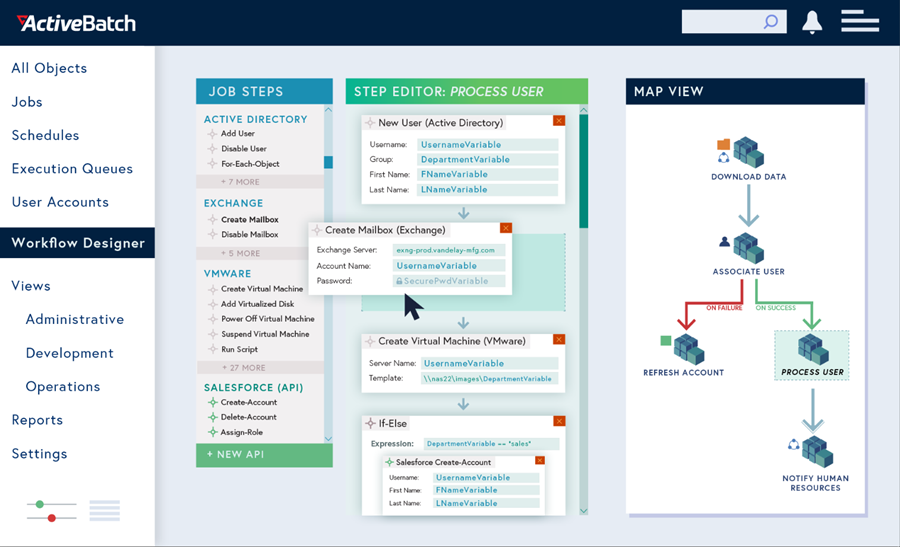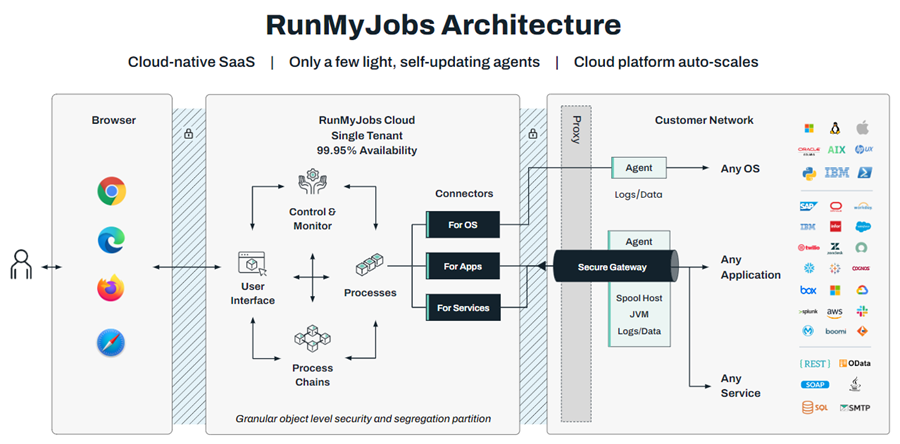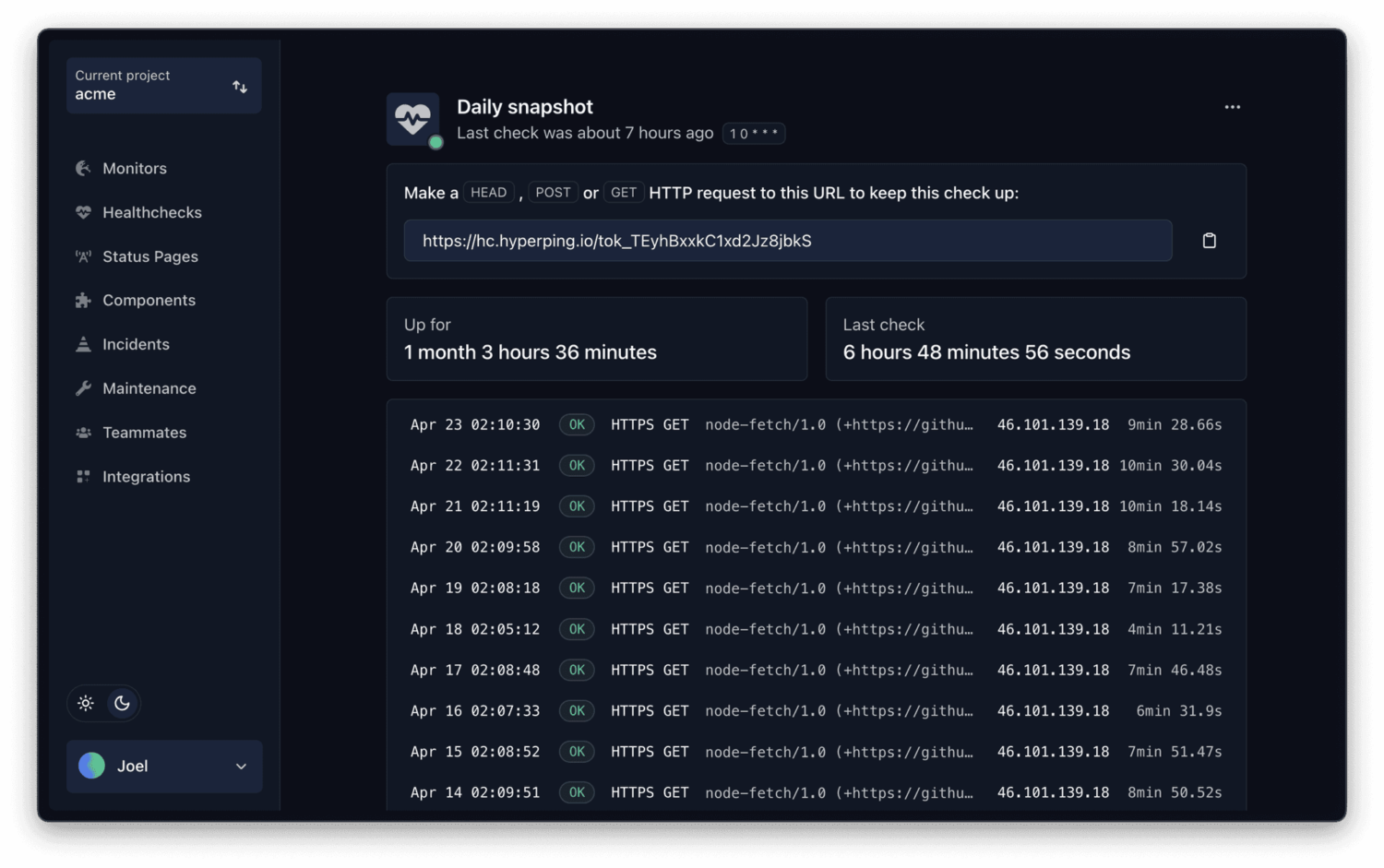Cron job is a utility that schedules scripts or commands to run automatically on a server at a specific date and time.
In the age of automation, people seek to save time by utilizing Cron jobs on Unix operating systems to automate tasks. Cloud-based Cron monitoring solutions can also be helpful in managing these tasks efficiently.
Cron jobs are used to automate repetitive tasks, and there are cloud-based Cron monitoring services available for managing these tasks. In this article, we explore some of the best cron job monitoring tools that can help you schedule your tasks efficiently.
- 1. ActiveBatch
- 2. Better Uptime
- 3. RunMyJobs by Redwood
- 4. Hyperping
- 5. HealthChecks
- 6. Cronitor
- 7. Cronhub
- 8. Dead Man’s Snitch
- 9. Web Gazer
- Show less
You can trust Geekflare
Imagine the satisfaction of finding just what you needed. We understand that feeling, too, so we go to great lengths to evaluate freemium, subscribe to the premium plan if required, have a cup of coffee, and test the products to provide unbiased reviews! While we may earn affiliate commissions, our primary focus remains steadfast: delivering unbiased editorial insights, and in-depth reviews. See how we test.
1. ActiveBatch
ActiveBatch is an easy-to-use, modern job scheduling and workload automation solution. This script-language independent solution allows your team to orchestrate business and IT processes. You can deploy the job scheduler on-premise, cloud, or hybrid environments.
Accelerate workflow creation using an intuitive, drag-and-drop, and no-code/low-code GUI. The integrated Cron Jobs Library by ActiveBatch offers 100+ pre-made job actions and templates.
ActiveBatch has an event-driven architecture to automate processes and improve scheduling efficiency, while customizable alerts and auto-remediation capabilities help minimize bottlenecks, job delays and failures, as well as SLA breaches.
ActiveBatch provides real-time metrics, manages resource provisioning, and protects existing custom scripts via lifecycle management capabilities. You will also get a load-balancing feature to automatically distribute workloads to achieve optimal allocation, performance, and resource utilization.
Stay compliant and secure with encrypted connections, vulnerability and penetration tests, and SOC 2 Type 1 and ISO 27001 certifications. ActiveBatch helps you improve job and system performance with automatic Health Checks. You’ll also receive alerts and notifications through email, SMS, SNMP, Twitter (X), JMS, and more.
Connect your business-critical applications and systems with powerful pre-built connectors from Informatica, Microsoft System Center, SAP, SQL Server, ServiceNow, Oracle, CyberArk, and more. ActiveBatch’s low-code REST API adapter offers infinite extensibility to all the current and future third-party services you use. It’s compatible with operating systems like Windows, macOS, IBM iSeries AS/400, UNIX, and Linux.
Get 24×7 world-class support with dedicated experts, strong SLAs, and a 15-minute response time. ActiveBatch’s free trial is available for up to 30 days. Request a personalized quote from the sales team today!
2. Better Uptime
Better Uptime is a modern monitoring service that combines cron and uptime monitoring, incident management, and status pages into a single, beautifully designed product.
The setup takes 3 minutes. After that, you get a call, email, or Slack alert whenever your Cron job doesn’t run correctly. The main features are:
- Cron job, API, Ping, HTTP(s), SSL & TLD expiration checks
- Unlimited phone call alerts
- Easy on-call scheduling
- Screenshots & error logs of incidents
- Slack, Teams, Heroku, AWS, and 100+ other integrations
3. RunMyJobs by Redwood
RunMyJobs is an enterprise Cron Job Scheduler and automation tool by Redwood that allows teams to schedule critical end-to-end business processes and monitor them effortlessly in a single dashboard. It enables your business systems, like ERP, CRM, etc., to work efficiently, requiring little to no human intervention.
RunMyJobs has a cloud-native architecture with 99.95% guaranteed uptime. It comes with an extensive pre-built jobs library and a drag-and-drop GUI to quickly create processes. It supports 25+ user interfaces and scripting languages like R, Python, Powershell, etc., and includes in-built parameter replacements and syntax highlighting.
Automate or schedule processes based on real-time events or data and ensure successful job completion with conditional logic and automated remediation. Get status overviews in real-time and a flexible report builder to manage reporting and monitoring.
RunMyJobs allows for complete lifecycle management with features such as rollbacks, audit trails, and integrated source controls. It provides security measures like TLS 1.2+ encryption, SSO/SAML authentication, granular permissions, ISO 27001 certification, Cloud Security Alliance STAR Level 1, as well as other compliance and security certifications.
You’ll get predictive SLA monitoring and proactive alerts on job delays or performance issues through email, SMS, or apps such as Microsoft Teams and Slack. RunMyJobs also allows you to use SOAP or REST web services in your workflows quickly using pre-built API wizards to integrate disparate applications and accelerate critical processes.
RunMyJobs enables DevOps, ERP, and self-service automation with web forms, emails, and SOA APIs. Take advantage of their 30-day free trial to see how RunMyJobs can streamline your workflow, enhance SaaS scalability, and simplify job management like never before.
4. Hyperping
Hyperping bundles uptime monitoring and status page service with a free forever plan to test things out risk-free.
It supports setting preferred cron job expressions and a timezone to get instant alerts via email, Slack, SMS, and more. Besides, it records job execution time and allows setting a grace period before it notifies you.
Based on the subscription, the checking interval can be as low as 10 sec. Hyperping also permits setting scheduled maintenance windows without affecting the overall uptime statistics. It runs its checks from 17 global data centers, which helps to pinpoint local outages and ensures uninterrupted cron job monitoring.
Every subscription supports unlimited projects with a predefined number of monitors. And you don’t have to do this alone since Hyperping lets you collaborate and share alerts with your team.
Finally, the 15-day no-credit card trial makes opting for Hyperping a no-brainer.
5. HealthChecks
The simplicity and effectiveness of HealthChecks make it one of the best choices for Cron job monitoring. It provides you with alerts for your weekly report triggers, schedule task failures, backup failures, and more.
Another impressive thing about HealthChecks is that it offers a unique URL for every periodic task for which the Cron Job monitoring is enabled. You can easily check HTTP service requests or send emails.
Using HealthChecks, the ratio of silent failures will eventually reduce. It features a live-updating dashboard that gives you details of all your alerts or checks. You can also assign names or tags to all your checks, which eventually help you easily recognize them afterward.
It comes with an easy configuration having ‘Grace Time’ and ‘Period’ parameters to indicate different aspects or statuses of monitoring. It allows you to add a detailed description for each check or Cron job.
You can add pointers and notes for your team to take further action. Plus, you can view sent or received ping history. Other features included are public status badges, Cron expression support, and integrations with Slack, Email, WebHooks, Microsoft Teams, etc.
6. Cronitor
Cronitor can assist you in scheduling tasks more conveniently with quick alerts. It works with multiple Cron jobs like AWS scheduled events, Microsoft tasks scheduler, Jenkins Job, Kubernetes Cron, Java Cron, and more.
Heartbeat monitoring allows you to get an insight into the health of data pipelines, background jobs, daemons, scripts, ETL jobs, and others. It is effortless to use in any language or platform and has flexible alert policies and rules.
Cronitor also offers uptime monitoring for a website, API, S3 buckets, etc.
7. Cronhub
Cronhub eradicates the need to write any codes for scheduling and monitoring background jobs. You just need to concentrate on your applications and let them schedule your tasks. You get instant alerts on your monitoring aspects as soon as any scheduled tasks are misaligned.
Schedule your jobs by utilizing Cron expressions or time intervals. For this, define an API or a targeted URL that executes on your job. Next, Cronhub sends an HTTP request to the API or targeted URL.
If the schedule gets interrupted for any reason, Cronhub will send immediate alerts through integrated channels such as SMS, Slack, Email, or others.
Apart from these, Cronhub also helps you keep track of the insights for your jobs and provides team support and log access. This will eventually help you track down the loopholes of your application along with the background jobs.
8. Dead Man’s Snitch
Dead Man’s Snitch picked up the pace when the Cron job monitoring services started booming. It targeted the point where the invoicing or the backup jobs malfunctioned in accordance with their schedules.
Dead Man’s Snitch ensures the developers and the users keep track of the Cron job operations the way they expected them to perform. It helps you monitor Cron, Heroku Scheduler, and more. It takes notification from the HTTP client, such as cURL, to inform the users about any malfunctioning.
Curl is the snippet that adds as a suffix to the Crontab line end. It proposes a request to Dead Man’s Snitch to check whether the job is operating or operated correctly or not. For different jobs, you can change the Snitch URLs to know the monitoring results for all of them.
Another interesting feature is the addition of the ‘Field Agent’ feature to the job. Download and Install it for better monitoring results along with metrics and data records. With it, you can check your Cron jobs’ error logs to help find better resolutions for them.
These features are a perfect blend to ensure you keep better track of your background jobs. Its pricing starts at just $5/month for three snitches and unlimited team members.
9. Web Gazer
Web Gazer helps you schedule the tasks and run monitoring on all those selected Cron jobs to track performance.
No false alarms are raised with Web Gazers as the incidents are validated within a fraction of a second before sending the alert to the user. Besides, Web Gazer provides heartbeat monitoring and SSL monitoring.
Its plan starts at $19/month, or you can also use it for free with basic features.
Basic Elements of Cron Job
A Cron job operates on three important components:
- Script – the script is the first infusion in the Cron Jobs that is called for execution.
- Schedule – when to trigger specified scripts.
- Action – action is the course of output that is experienced after the final execution.
Types of Cron Jobs that require monitoring
Missing out on the Cron job notifications has no immediate repercussions, but it may hamper the system eventually. Some of the Cron jobs that usually go unnoticed without the use of an efficient monitoring service are:
- Backups
- SSL Cert renewal
- Antivirus scan
- Dynamic DNS updates
- Server reboot
and a lot more…
Perks of Cron Job monitoring
Apart from the true efficacy of Cron jobs in offering progressive control over the running execution with time, monitoring services come with these practical perks:
- Job Scheduling – using any type of Cron expression or time intervals, scheduling jobs is now an easy task.
- Instant Alerts – if any of the application or job processes take more time than expected, then these services will give instant alerts.
- Metric Insights – you can track all the metrics of jobs as well as monitor them to take better actions.
Conclusion
Scheduling and monitoring Cron jobs are essential for ensuring the smooth operation of your automated tasks. By implementing the solutions discussed above, you’ll gain valuable insights and streamline tasks.

